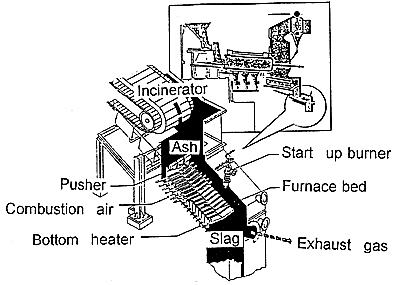Waste Treatment Technology in JAPAN
Ash Handling
IHI has developed the ash melting system, which is compact and reduces the quantity of external melting energy to an absolute minimum. The system is not only capable of melting the incinerator ash which contains harmful substances, but also makes it possible to obtain reutilized products.
The ash vitrifies, and changes to low-elute and environmentally compatible slag. The slag can be considered for a large number of possible uses, e. g. for road construction or for construction industry aggregates.
Applying calorie of refuse to melt ash achieves this system. In an incinerator, under combustion control refuse burns and changes to ash with some amount of residue carbon. The ash is provided to the ash melting furnace which locates at the incinerator outlet and vitrifies at temperature of 1200 to 1500 deg.C (depending on the ash components) by the residue carbon combustion energy.
The system consists of the following elements.
(1)Ash melting furnace
Construction of Ash Melting Furnace
(1)Environmentally compatible system.
Clean Center Kinuura: 30t/day(15t/day X 2), Aichi Pref. JAPAN
1.Principal of ash melting
2.Construction
* Pusher: to provide ash into the furnace automatically.
(2)Combustion air fan:
to provide combustion air for the residue carbon from the furnace bed. The exhaust
gas is induced to the incinerator gas system and purified under the crude gas
emission limits.
(3)Slag granulation or casting equipment:
to cool molten slag immediately by water (granulation) or gradually in the air
(casting) depend on slag uses.

3.Features
(2)Economical system fueled by the residue carbon in ash.
(3)Very compact and small installation space enough.
(4)Low initial cost and low running cost.
4.Example of the plant
NOTE: IHI has been developed other ash melting systems by Joule heat and by coke-
bed.